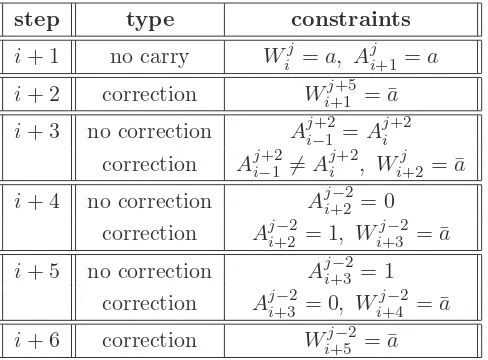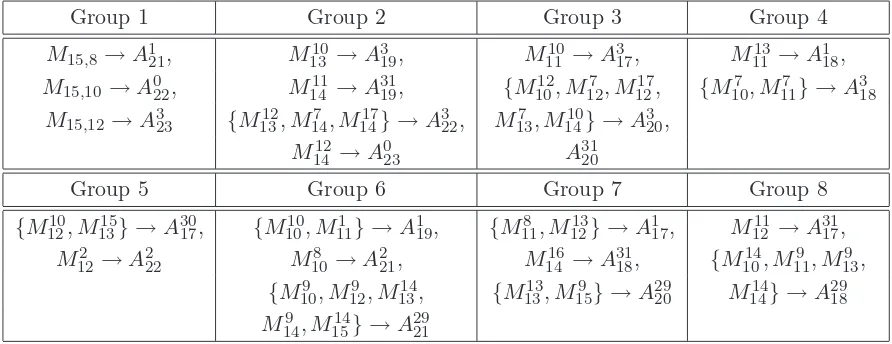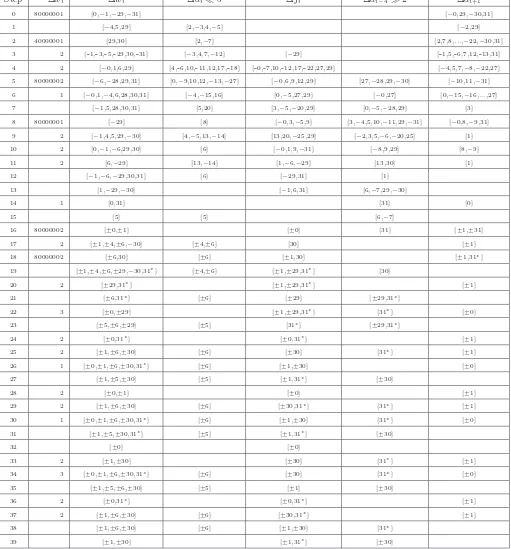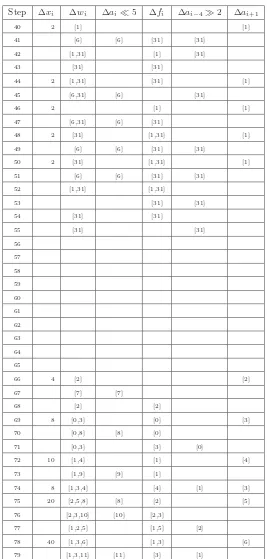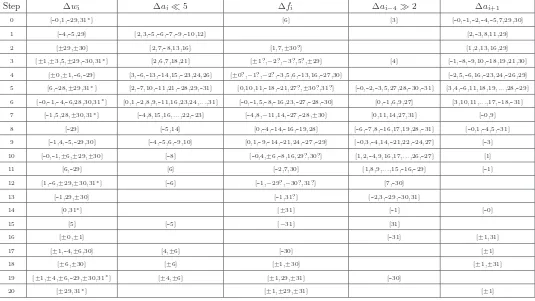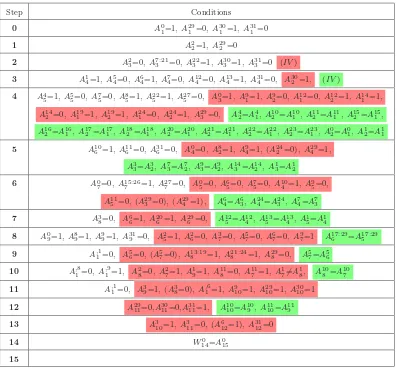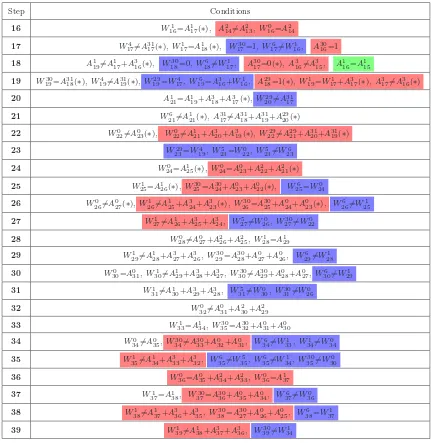Notes on the Wang et al.
2
63SHA-1 Differential Path
Martin Cochran∗
August 24, 2008
Abstract
Although advances in SHA-1 cryptanalysis have been made since the 2005 announcement of a 263 attack by Wang et al., the details of the attack have not yet been vetted; this note does just that. Working from Adi Shamir’s 2005 CRYPTO rump session presentation of Wang et al.’s work, this note corroborates and presents the differential path and associated conditions for the two-block attack. Although the error analysis for the advanced condition correction technique is not verified, a method is given which yields a two-block collision attack on SHA-1 requiring an estimated 262 SHA-1 computations if the original error analysis by Wang et al. is correct.
Keywords: Cryptographic Hash Functions, Cryptanalysis, SHA-1
1
Introduction
In the rump session at CRYPTO 2005 on behalf of Xiaoyung Wang, Andrew C. Yao and Frances Yao, Adi Shamir gave a short talk detailing a differential path which could be used to find a collision in SHA-1 with an expected 263 SHA-1 compression function invocations [30]. Although
some details of their methodology were given, over two years have passed and there seems to be little comprehension of the result. The aim of this document is to verify both the differential path and complexity estimation given in [30]. It is not my intention to “steal” any forthcoming publication by the authors of [30]; I am not planning to publish this note in a peer-reviewed medium but instead hope that it may aid researchers in the area.1
Main Results. This note contains details for a two-block differential path similar (but not
iden-tical) to that given in [30] and a set of sufficient conditions which guarantee the path holds. The results do not correlate exactly with the data summarized in [30], but the differences are minor and, assuming the original advanced modification error probability is correct, the main figures and estimations are substantiated. Namely, after all conditions are enumerated and advanced condition modification methods and early stopping techniques are taken into account, an expected 262SHA-1
∗Department of Computer Science, 430 UCB, Boulder, Colorado 80309 USA. E-mail: Martin.Cochran@gmail.com
invocations are needed to find a collision. The apparent complexity improvement is achieved by using an “early stopping” technique used in the analysis from [31]. Additionally, to arrive at this figure many paths related to the main differential path are used which aids the attack complexity by a factor of four. It is possible, although perhaps not likely, that these differential paths were not considered by the authors of [30] and could be combined with their methods to yield a faster attack.
The differential path is given in Figures 2, 3 and 4, the sufficient conditions for which are given in Figures 5, 6 and 7. I also describe an advanced condition modification technique to correct many conditions past step 16 and try to interpret other statements made in [30] regarding degrees of message freedom before and after advanced condition modification. I stress that everything here is a “best guess” at what the authors of [30] intended, but it seems likely that the results are highly correlated.
Previous Cryptanalysis of SHA-1. Starting in 2004 at the CRYPTO rump session, a series
of breakthrough attacks on hash functions were presented by Wang and company [29, 31–33]. In the earlier two papers, more efficient attacks were found on MD4, HAVAL, and RIPEMD, among others, and a collision for the widely used MD5 was given. A summary of the methods used in these papers can be found in [4, 5].
Biham et al. [3] provided the first collision in SHA-0, stemming from work in [2] and earlier analysis by Chabaud and Joux [8]. In the same paper they began to chip away at the security of SHA-1, giving a collision in a reduced 40-step version. Shortly thereafter in 2005 Wang et al. published a more efficient collision attack [33] on SHA-0 and at the same conference Wang, Lin and Yu extended the techniques to the full SHA-1 in [31]. In that paper they give a complexity estimate of 269 expected computations of SHA-1 for their attack, besting the general theoretical attack of
280 computations. At that point many considered SHA-1 to be “broken,” although performing 269
work is arguably not practical in any reasonable time frame. A day after the talk for [31] was given, Shamir presented the 263attack, apparently a very recent result at the time, for the figures differed
slightly from a lengthier presentation at the NIST hash function workshop a few days later [25]. All specific figures refer to this later presentation.
More recently at the 2007 CRYPTO conference Joux et al. presented a paper [13] on an application of Wagner’s boomerang attack [28] to compression functions in general, SHA-1 in particular. At the rump session of the same conference Christian Rechberger presented [16] work done with Vincent Rijmen based on earlier work with Christophe De Canni`ere [7] where he described the best current known attack, utilizing many different differential paths. The estimate given in [16] was 260.x expected calls to the SHA-1 compression function. There has also been some work
by Sugita, Kawazoe, Perret and Imai [26] to provide a theoretical foundation for the advanced condition modification methods of Wang et al.
2
Background, Notation
integers and all arithmetic is done modulo 232. For two 32-bit variablesx andy,x∧y denotes the
logical bitwise ‘AND’ ofxand y, and likewise x∨yand x⊕yare used to denote the logical bitwise
‘OR’ and ‘XOR’, respectively, ofx and y. The left (right) circular shift ofx by nbits is denoted
asx&n (x'y), and the bitwise complement ofx is denoted as ¯x. The j-th least significant bit
of a variable Mi is denoted byMij.
Foundations. Generally, a cryptographic hash function is a function
H :{0,1}∗→ {0,1}n
for somen.
A formal discussion of hash function security notions and the relations between them can be found in [23], but the following are the three informal properties desired by designers of hash functions:
• Pre-image Resistance Given y ∈ {0,1}n, it is “difficult” to find x ∈ {0,1}∗ such that H(x) =y.
• Second Pre-image Resistance Given x ∈ {0,1}∗, it is “difficult” to find x" ∈ {0,1}∗, x" )=x, such thatH(x) =H(x").
• Collision Resistance It is “difficult” to find any two x, x" ∈ {0,1}∗ such that x )= x" and H(x) =H(x").
There are some problems encoding these requirements in a complexity-theoretic framework (see [22] for a thorough discussion). However, some guiding upper bounds for expected attack complexity of candidate hash functions can be obtained by examining theoretical attacks. A simple probabilistic attack can be used to obtain chosen pre-images and second pre-images in time O(2n) and O(1)
space, and a general collision attack based on Pollard’s method [21] can be mounted withO(2n/2)
invocations and a constant amount of space. Most designers of hash functions try to achieve the strongest security property, collision resistance, and thus any proposed hash has its security judged against the O(2n/2) attack.
Although there are many possible ways to construct a hash function, SHA-1 and most others are iterated via a compression function, utilizing the well-known result simultaneously discovered by Merkle [17] and Damg˚ard [10] that a collision-resistant hash function accepting strings of arbitrary length may be constructed from a collision-resistant compression function which has two inputs of fixed length.
With the additional structure imposed by the Merkle-Damg˚ard paradigm, improvements to the above theoretical attacks are possible. Kelsey and Schneier [15] have shown a second pre-image attack on any Merkle-Damg˚ard hash function that requires about k2n/2+1+ 2n−k+1 hash
function calls to find a second pre-image on a message of block-length 2k. Similarly, because most
further in [27]. There have been other recent interesting results on Merkle-Damg˚ard hash functions [12, 14], but they are mostly unrelated to this note.
SHA-1. SHA-1 (Secure Hash Algorithm-1), based on the MD function family due to Ron Rivest
and using the Merkle-Damg˚ard paradigm, was standardized by NIST in 1995 [19]. It replaced a similar hash, SHA-0, then known simply as “SHA.”
The SHA-1 compression function, denoted asSHAc, takes as input a 160-bit chaining value CV,
broken into five 32-bit values such that CV = CV0"CV1"CV2"CV3"CV4, and a 512-bit message
input M, with M =M0"M1" . . . "M15,|Mi|= 32.
The full SHA-1 on input message M is computed by using Merkle-Damg˚ard strengthening
[10, 17] and padding to obtain a message M" such that |M"| is a multiple of 512. Let M" = M0" "M1" " . . . "M!", where|Mi"|= 512, for some ! and let
IV0=0x67452301"0xefcdab89"0x98badcfe"0x10325476"0xc3d2e1f0.
Define IVi+1=SHAc(IVi, Mi"). Then the SHA-1 output on inputM is IV!+1.
SHAc. The compression function of SHA-1 consists of 80 steps producing 80 intermediate step values Ai for 1≤i≤80. Additionally, the valuesA0, A−1, A−2, A−3, andA−4 are initialized with
CV0,CV1,(CV2 &2),(CV3 &2) and (CV4 &2), respectively.
The 80 step values are computed iteratively by the following recurrence:
Ai+1←(Ai&5) +fi(Ai−1,(Ai−2 '2),(Ai−3 '2)) + (Ai−4 '2) +Wi+Ki
wherefiis called theround function,Kiis a step-dependent constant andWiis a variable computed
from the input message. The message expansion for determining the Wi for 0≤i <80 is defined
by the following.
Wi =
!
Mi : if i <16
(Wi−3⊕Wi−8⊕Wi−14⊕Wi−16)&1 : otherwise
The function fi is divided into four rounds (I will sometimes call it a round function) and is
defined as follows:
fi(x, y, z) =
(IF) : (x∧y)∨(¯x∧z) : if 0≤i <20
(XOR) :x⊕y⊕z : if 20≤i <40
(MAJ) : (x∧y)∨(x∧z)∨(y∧z) : if 40≤i <60
(XOR) :x⊕y⊕z : if 60≤i <80
The output of SHAc is
A80+ CV0"A79+ CV1"(A78'2) + CV2"(A77'2) + CV3"(A76'2) + CV4
XOR Differential vs. Subtraction Differential. The notation in the differential path
unsigned integersx, x", consider the function ∆X(x, x") =x⊕x". This defines the XOR differential
forx, x". Alternatively, define ∆S(x, x") asx"−x mod 232. This is the subtraction differential. The
value of one differential does not imply the value of the other. For example, let ∆S(x, x") = 22.
There are many possibilities for ∆X(x, x"):
• ∆X(x, x") =0x00000004 (there is only one bit different between xand x", in index 2)
• ∆X(x, x") =0x0000000c (bit 3 is set inx" but is not set inx, bit 2 is not set inx" but is set
inx)
• ∆X(x, x") =0x0000fffc (bit 15 is set in x" but is not set inx, bits 2 through 14 are not set
inx" but are set in x
The differential used here in Figures 2, 3 and 4 (and originally in [29, 32]) resolves this problem with the following notation. Letx be in [0,231−1]. Then x" =x[a1, a2, . . . , an,−b1,−b2, . . . ,−bm]
denotesx" =x+ 2a1+ 2a2+· · ·+ 2an−2b1−2b2· · · −2bm mod 232. From this information one can
compute both ∆X(x, x") and ∆S(x, x") if and only if for every bit indexifor which xand x" differ
i∈ {a1, a2, . . . , an, b1, b2, . . . , bm}.
3
Methods
The Wang et al. collision attacks are differential attacks, whereby a pair of messages M, M" is
chosen such that ∆(M", M) = δ for some prescribed function (or set of functions) ∆ and some
prescribed value (vector)δ. LetAi, 1≤i≤80 be the step values computed on inputM and define
A"i likewise for M". The attacker then tracks the values ∆(A"i, Ai) throughout the computation of
the compression function, but is mostly uninterested in the values of A"i and Ai themselves. A
differential path specifies target values ∆tA
i for all i and is usually associated with some set of
conditions on the Ai, CV, andM which guarantee that ifAi, CV, andM satisfy those conditions,
then given the messageM" ←M+δ and the associated valuesA"i, ∆tAi =A"i−Ai for all relevant
i. The recent attacks all use the value of CV which is of interest, the specified initial value, so the
task then becomes efficiently finding a messageM such that the sufficient conditions are satisfied.
The Wang et al. attack on SHA-1 described in this note uses a two-block differential path. The first block has 305 total conditions, all but 85 of which are easily satisfied deterministically. Of those remaining conditions, 20 may be satisfied with advanced methods with probability around 1/2 according to [30], leaving effectively 65 conditions which are satisfied probabilistically. The
second-block path also effectively has 65 conditions that cannot be satisfied deterministically. The heuristic for determining the attack complexity, useful in practice, is to assume that each condition is satisfied with probability 1/2. Typically, the differential path is chosen so that as many conditions
may be satisfied deterministically as possible, which in practice means the differential paths have very few conditions in the later rounds. The actual attack complexity considers several other factors and is discussed later.
Local Collisions. A theme among collision attacks on the SHA family is the idea of ‘local
step type constraints
i+ 1 no carry Wij =a, Aji+1=a i+ 2 correction Wi+1j+5 = ¯a i+ 3 no correction Aj+2i−1 =Aj+2i
correction Aj+2i−1 )=Aj+2i , Wi+2j = ¯a i+ 4 no correction Aji+2−2= 0
correction Aji+2−2= 1, Wi+3j−2 = ¯a i+ 5 no correction Aji+3−2= 1
correction Aji+3−2= 0, Wi+4j−2 = ¯a i+ 6 correction Wi+5j−2 = ¯a
Table 1: A local collision with associated conditions in round 1. A difference is introduced by a change inWij,
and conditions can be chosen to absorb differences inWij+2, Wij−+32, andWij−+42. Regardless, a change inWij−+52 is required to correct the possible change in stepi+ 6.
by other differences introduced in the following five steps. In this way a local collision is self-contained; the differences do not continue to propagate after those five steps. There are many ways to construct local collisions, but the one first mentioned in [8] and used in most attacks on SHA-1 was chosen for the relatively few number of conditions required for the local collision to occur. Table 1, summarizing a first round local condition and its related sufficient conditions, was taken from [13].
As can be seen from the table, depending on the round and the whether or not corrections are needed, there are four conditions on Aji and up to 5 conditions on Mij to ensure a local collision
occurs in the first round. In [31] and [30], a specialized differential path is used in the first round and the local collision differential paths are only employed in later rounds, and the same is true with the path presented here. Note that the correction for step i+ 2, for example, is a condition only
involving the message-dependent values Wi. As such this may be easily deterministically satisfied,
even in later rounds, by computing via the message expansion function the relevant set of linear equations overGF2 for the target bits (Wi+1j+5 andW
j
i in this case), and using Gaussian elimination.
Disturbance Vector. A major component of the Wang et al. SHA-1 attack is their choice of a
disturbance vector, which is simply a choice of where to introduce local collisions. We can think of a disturbance vector as an 80×32 binary array, indexed byi, j, such that ifi, jis 1 in the disturbance
vector, then a local collision is introduced in stepi, bitj. By the message expansion function, once
The disturbance vector in [30] (and here) is the same as the disturbance vector in [31], but shifted by 2 steps. In [31], 71 conditions (not including message conditions) occurred in steps 16-79, and in the path presented here there are 85 such conditions (83 if considering the extra differential paths), but there is also a way to easily correct 20 of them.
Although the disturbance vector provides a map of the differential path in later rounds, a fact that greatly aided the reconstruction of the path, in the first round the differential path ignores the disturbance vector. Motivation for why this was done is presented in [31].
A trick to save a few conditions is mentioned in [31], where if within one step there are dis-turbances in both bits 0 and 1 and the signs of those two differences are opposite, the introduced difference can be confined to bit zero. The message differences still can be used to form a local collision, and two fewer conditions are required. In the path presented here, this trick is employed in steps 22 and 34.
Alternate Differential Paths. The differences introduced in steps 22, 26, 30, 34, 66, 69, 72,
74 and 75 have multiple differential paths associated with them. For instance, in step 26 if the introduced difference inA027 causes a carry, then with only one extra message condition and slight
alterations to existing conditions the same local collision occurs. The net result is an alternate differential path with one extra message condition and one extra regular condition. All alternate paths involve this same trick of one carry, and each path has up to four extra conditions. When all of these alternate paths and their combinations are taken into account, it has the effect of reducing the complexity by a factor of 4. By my count, there are 85 conditions in steps 16-79, compared to 83 given by [30]; perhaps these alternate paths are factored into that figure. If there is another means of reducing the 85 conditions to 83 which does not interfere with the alternate differential paths, it is possible that a combination of methods can result in an attack with 260 complexity.
Advanced Condition Modification. There are 85 conditions in steps 16-79, which can be
reduced to 83 by the multiple differential paths. In order to obtain an attack complexity of 263, 20
conditions must be satisfied deterministically via a process calledadvanced condition modification.
There are several key ideas to Wang’s advanced condition modification techniques, perhaps best explained by the following series of insights.
• The message conditions can be expressed as equations over GF2 with variables in Wij for
i < 16, 0 ≤ j < 32 by simply expanding the desired bit Wij via the recurrence formula.
There are 43 such equations, which can be easily solved deterministically before advanced condition modification.
• There are 50 variables inWij for 10≤ i <16, 0 ≤j <32 which are involved in not one of
these equations. When changes inW9 are allowed, this number increases to 59.
• A control path is a possible bit propagation chain from Wij to some bit Aji"". It is easy to
generate all possible control paths from the 50 free message bits to conditions on Aji for
17≤i <26. In order to simplify the analysis, I ignored carry effects in finding control paths.
[30] did the analysis with the carry effects intact, which gave a probability of 1/2 that the
Group 1 Group 2 Group 3 Group 4
M15,8 →A121, M1310→A319, M1110→A317, M1113→A118,
M15,10→A022, M1411→A3119, {M1012, M127 , M1217, {M107 , M117 } →A318
M15,12→A323 {M1312, M147 , M1417} →A322, M137 , M1410} →A320,
M12
14 →A023 A3120
Group 5 Group 6 Group 7 Group 8
{M10
12, M1315} →A3017, {M1010, M111 } →A119, {M118 , M1213} →A171 , M1211→A3117,
M122 →A222 M108 →A221, M1416→A3118, {M1014, M119 , M139 ,
{M9
10, M129 , M1314, {M1313, M159} →A2920 M1414} →A2918
M149 , M1514} →A2921
Figure 1: Restrictions on the ways 22 conditions may be modified by flipping free message bits when carry effects are ignored. All conditions may be satisfied by processing all the conditions within each group at the same time, and processing the groups in reverse order.
• After generating the above graph, it is possible to find a set of free message bitsM which
can be used to flip all desired condition bits through step 23.
• Some message bits will flip multiple bits with associated conditions, so it is necessary to
determine an order for flipping which won’t undo previous corrections. I found that there are eight sets of flips and associated conditions, explained further in Figure 1.
• Now consider the carry effects and find an order for flipping conditions which minimizes the
probability that a previously fixed condition is undone. I have not done this here, but [30] claims that this probability is about 1/2 for their “topological order.” Their technique uses
multiple message differences, instead of the single bit flipping presented here. In the example from [30], three differences are introduced which give a local collision starting at step 11; the message differences don’t produce uncontrolled differences in the step values until step 19, which reduces the probability that some earlier difference in a step variable undoes a prior condition.
• The extra conditions for the advanced condition modification in [30] are derived from round
1 conditions which guarantee a change in the message bit will (or will not) produce a change in ∆fi in subsequent steps.
The (simplified) corrections presented in Table 1 will satisfy all conditions through step 23, and five of the conditions in steps 24-26. In addition, if both of the conditions{W0
24=A125, W251 =A126}
are unsatisfied, a change in the bit A322 will correct both conditions, effectively eliminating one
With an average of 10 needed condition corrections per iteration, and simple bit-flipping as the message modification method, an average of less than 40 step computations are needed to correct all conditions through step 25, thereby canceling the effect of that with probability 1/2 the advanced
modification method undoes itself. This early stopping technique was used for the estimate in [31], so it seems reasonable to use it here to lower the attack complexity.
Complexity Estimation Justification. The total complexity is calculated as follows. After
all differential paths are considered, there are an equivalent of 83 conditions which need to be satisfied in steps 16-79, but the carry condition in step 78 can be safely dropped with negligible error probability (2−25). Advanced condition modification will satisfy an equivalent of 20 conditions
with probability 1/2, which is counted as balancing the dropped condition in step 78. The early
stopping technique then brings the attack complexity to 262.
For the first block, three more conditions in steps 78-79 can be dropped, which has the effect of changing the values of ∆A79 and ∆A80 from those presented in Figure 3. These differences are
easily accommodated by the first 10 steps of the second-block differential path. Thus, the total attack complexity is 259+ 262= 1.125×262.
Differences from Wang et al. Path. There are some differences from the path presented by
Wang et al. in [30]:
• The differentials for the first 16 steps do not match. However, it is simple to check that the
example 320-bit message prefix given in [30] does not follow their own differential path, but instead follows the path given here.
• I found 43 message conditions instead of 42, plus one extra condition for use with the
asso-ciated differential paths. This is probably because the classification of one of the message conditions in step 19 is open to interpretation.
• The set of unrestricted message bits after satisfying message conditions is somewhat different.
I have no plausible explanation.
• [30] claims to have a free message space of size 255after advanced modifications. I’m not sure
what is meant by this, but calculating a rough estimate of message freedom is straightforward: there are 20 conditions in steps 10-16, plus 43 message conditions and 22 message bits used for advanced condition modification. Thus, with 7×32 = 224 original bits, there is essentially a
message space of about 2139, for which 63 conditions need to be satisfied probabilistically. The
“message space available for direct modification” is probably related to the 59 free message bits in message wordsM9 through M15 available to change after all message conditions are
satisfied.
• I have not investigated the scenario where, once all advanced modifications have been
• I can only speculate if my advanced condition modification techniques are what the original
authors had in mind. My methods seem to provide correction of an equal number of conditions but, judging by the cleverness inherent in all other aspects of their attack for which they provided details, I suspect their methods are more efficient or have some other beneficial properties.
4
The Differential Path
The relevant information for the differential path is contained entirely in Figures 2, 3, 4, 5, 6 and 7. All conditions listed for a stepiare used for some correction or condition needed for that step value
computation. Conditions are color-coded for clarity: blue conditions are conditions on message bits, red conditions are needed to produce an output difference or some desired property thereof from the step functionfi, green signifies conditions which are needed so that no differences are produced
via fi, and conditions which are not colored are required to satisfy desired carry effects.
5
Acknowledgments
Step ∆xi ∆wi ∆ai!5 ∆fi ∆ai−4"2 ∆ai+1
0 80000001 [0,−1,−29,−31] [−0,29,−30,31]
1 [−4,5,29] [2,−3,4,−5] [−2,29]
2 40000001 [29,30] [2,−7] [2,7,8,...,−22,−30,31]
3 2 [-1,-3,-5,-29,30,-31] [−3,4,7,−12] [−29] [-1,5,-6,7,12,-13,31]
4 2 [−0,1,6,29] [4,-6,10,-11,12,17,-18] [-0,-7,10,-12,17,-22,27,29] [−4,5,7,−8,−22,27] 5 80000002 [−6,−28,29,31] [0,−9,10,12,−13,−27] [−0,6,9,12,29] [27,−28,29,−30] [−10,11,−31]
6 1 [−0,1,−4,6,28,30,31] [−4,−15,16] [0,−5,27,29] [−0,27] [0,−15,−16,...,27] 7 [−1,5,28,30,31] [5,20] [3,−5,−20,29] [0,−5,−28,29] [3] 8 80000001 [−29] [8] [−0,3,−5,9] [3,−4,5,10,−11,29,−31] [−0,8,−9,31]
9 2 [−1,4,5,29,−30] [4,−5,13,−14] [13,20,−25,29] [−2,3,5,−6,−20,25] [1] 10 2 [0,−1,−6,29,30] [6] [−0,1,9,−31] [−8,9,29] [8,−9]
11 2 [6,−29] [13,−14] [1,−6,−29] [13,30] [1]
12 [−1,−6,−29,30,31] [6] [−29,31] [1]
13 [1,−29,−30] [−1,6,31] [6,−7,29,−30]
14 1 [0,31] [31] [0]
15 [5] [5] [6,−7]
16 80000002 [±0,±1] [±0] [31] [±1,±31]
17 2 [±1,±4,±6,−30] [±4,±6] [30] [±1]
18 80000002 [±6,30] [±6] [±1,30] [±1,31∗]
19 [±1,±4,±6,±29,−30,31∗] [±4,±6] [±1,±29,31∗] [30]
20 2 [±29,31∗] [±1,±29,31∗] [±1]
21 [±6,31∗] [±6] [±29] [±29,31∗]
22 3 [±0,±29] [±1,±29,31∗] [31∗] [±0]
23 [±5,±6,±29] [±5] [31∗] [±29,31∗]
24 2 [±0,31∗] [±0,31∗] [±1]
25 2 [±1,±6,±30] [±6] [±30] [31∗] [±1]
26 1 [±0,±1,±6,±30,31∗] [±6] [±1,±30] [±0]
27 [±1,±5,±30] [±5] [±1,31∗] [±30]
28 2 [±0,±1] [±0] [±1]
29 2 [±1,±6,±30] [±6] [±30,31∗] [31∗] [±1]
30 1 [±0,±1,±6,±30,31∗] [±6] [±1,±30] [31∗] [±0]
31 [±1,±5,±30,31∗] [±5] [±1,31∗] [±30]
32 [±0] [±0]
33 2 [±1,±30] [±30] [31∗] [±1]
34 3 [±0,±1,±6,±30,31∗] [±6] [±30] [31∗] [±0]
35 [±1,±5,±6,±30] [±5] [±1] [±30]
36 2 [±0,31∗] [±0,31∗] [±1]
37 2 [±1,±6,±30] [±6] [±30,31∗] [±1]
38 [±1,±6,±30] [±6] [±1,±30] [31∗]
39 [±1,±30] [±1,31∗] [±30]
Step ∆xi ∆wi ∆ai!5 ∆fi ∆ai−4"2 ∆ai+1
40 2 [1] [1]
41 [6] [6] [31] [31]
42 [1,31] [1] [31]
43 [31] [31]
44 2 [1,31] [31] [1]
45 [6,31] [6] [31]
46 2 [1] [1]
47 [6,31] [6] [31]
48 2 [31] [1,31] [1]
49 [6] [6] [31] [31]
50 2 [31] [1,31] [1]
51 [6] [6] [31] [31]
52 [1,31] [1,31]
53 [31] [31]
54 [31] [31]
55 [31] [31]
56 57
58 59 60
61 62 63
64 65
66 4 [2] [2]
67 [7] [7]
68 [2] [2]
69 8 [0,3] [0] [3]
70 [0,8] [8] [0]
71 [0,3] [3] [0]
72 10 [1,4] [1] [4]
73 [1,9] [9] [1]
74 8 [1,3,4] [4] [1] [3]
75 20 [2,5,8] [8] [2] [5]
76 [2,3,10] [10] [2,3]
77 [1,2,5] [1,5] [2]
78 40 [1,3,6] [1,3] [6]
79 [1,3,11] [11] [3] [1]
Step ∆wi ∆ai!5 ∆fi ∆ai−4"2 ∆ai+1
0 [-0,1,-29,31∗] [6] [3] [-0,-1,-2,-4,-5,7,29,30]
1 [-4,-5,29] [2,3,-5,-6,-7,-9,-10,12] [2,-3,8,11,29]
2 [±29,±30] [2,7,-8,13,16] [1,7,±30?] [1,2,13,16,29] 3 [±1,±3,5,±29,-30,31∗] [2,6,7,18,21] [±1?,−2?,−3?,5?,±29] [4] [-1,-8,-9,10,-18,19,21,30] 4 [±0,±1,-6,-29] [3,-6,-13,-14,15,-23,24,26] [±0?,−1?,−2?,-3,5,6,-13,16,-27,30] [-2,5,-6,16,-23,24,-26,29] 5 [6,-28,±29,31∗] [2,-7,10,-11,21,-28,29,-31] [0,10,11,-18,-21,27?,±30?,31?] [-0,-2,-3,5,27,28,-30,-31] [3,4,-6,11,18,19,...,28,-29]
6 [-0,-1,-4,-6,28,30,31∗] [0,1,-2,8,9,-11,16,23,24,...,31] [-0,-1,5,-8,-16,23,-27,-28,-30] [0,-1,6,9,27] [3,10,11,...,17,-18,-31]
7 [-1,5,28,±30,31∗] [-4,8,15,16,...,22,-23] [-4,8,−11,14,-27,-28,±30] [0,11,14,27,31] [-0,9] 8 [-29] [-5,14] [0,-4,-14,-16,-19,28] [-6,-7,8,-16,17,19,28,-31] [-0,1,-4,5,-31]
9 [-1,4,-5,-29,30] [-4,-5,6,-9,10] [0,1,-9,-14,-21,24,-27,-29] [-0,3,-4,14,-21,22,-24,27] [-3] 10 [-0,-1,±6,±29,±30] [-8] [-0,4,±6,-8,16,29?,30?] [1,2,-4,9,16,17,...,26,-27] [1] 11 [6,-29] [6] [-2,7,30] [1,8,9,...,15,-16,-29] [-1]
12 [1,-6,±29,±30,31∗] [-6] [-1,−29?,−30?,31?] [7,-30]
13 [-1,29,±30] [-1,31?] [-2,3,-29,-30,31]
14 [0,31∗] [±31] [-1] [-0]
15 [5] [-5] [−31] [31]
16 [±0,±1] [-31] [±1,31]
17 [±1,-4,±6,30] [4,±6] [-30] [±1]
18 [±6,±30] [±6] [±1,±30] [±1,±31]
19 [±1,±4,±6,-29,±30,31∗] [±4,±6] [±1,29,±31] [-30]
20 [±29,31∗] [±1,±29,±31] [±1]
Figure 4: The second-block differential path for steps 1-20; steps 21-80 are identical to the first-block path. To avoid adding conditions for the chaining values, the signs of the message differences may vary. Similarly, the values for∆fi may differ depending on the conditions. These cases are indicated by a ‘±’ for the message bits,
Step Conditions
0 A01=1, A291 =0, A301 =1, A311 =0
1 A22=1, A292 =0
2 A2
3=0, A7:213 =0, A223 =1, A303 =1, A313 =0 (IV)
3 A1
4=1, A54=0, A64=1, A74=0, A412=0, A134 =1, A314 =0, A302 =1, (IV)
4 A4
5=1, A55=0, A75=0, A85=1, A225 =1, A275 =0, A03=1, A91=1, A92=0, A121 =0, A122 =1, A141 =1,
A14
2 =0, A191 =1, A192 =1, A241 =0, A242 =1, A293 =0, A42=A41, A102 =A101 , A112 =A111 , A152 =A151 ,
A16
2 =A161 , A172 =A171 , A182 =A181 , A202 =A201 , A212 =A211 , A222 =A221 , A232 =A123, A02=A01, A12=A11
5 A10
6 =1, A116 =0, A316 =0, A04=0, A28=1, A94=1,(A242 =0), A294 =1,
A3
3=A32, A73=A72, A93=A92, A143 =A142 , A13=A12
6 A0
7=0, A15:267 =1, A277 =0, A05=0, A65=0, A75=0, A104 =1, A95=0,
A11
5 =0,(A293 =0),(A294 =1), A64=A63, A244 =A243 , A74=A73
7 A3
8=0, A66=1, A206 =1, A296 =0, A125 =A124 , A135 =A134 , A15=A14
8 A0
9=1, A89=1, A99=1, A319 =0, A25=1, A26=0, A37=0, A57=0, A67=0, A97=1 A17:296 =A17:295
9 A,11=0, A5
6=0,(A57=0), A13:198 =1, A821:24=1, A298 =0, A57=A56
10 A,18=0, A,19=1, A2
8=0, A27=1, A19=1, A118 =0, A117 =1, A17$=A18, A108 =A107
11 A,11=0, A3
9=1,(A38=0), A,16=1, A910=1, A2910=1, A3010=1
12 A29
11=0,A3011=0,A3111=1, A1010=A109 , A1110=A119
13 A3
10=1, A311=0,(A612=1), A3112=0
14 W0
14=A015
15
Figure 5: The set of sufficient conditions for the first 16 steps of the first block differential path. Conditions to prevent carry effects are uncolored, message conditions are blue, conditions required to produce or correct a change in ∆fi are colored with red, and conditions required to prevent a change in ∆fi are green. Conditions
enclosed in parentheses are redundant and conditions followed by an ‘(∗)’ can be affected by advanced condition correction. The notationAji:k is used as shorthand forA
j i =A
j+1
Step Conditions
16 W1
16=A117(∗), A214$=A213, W160=A214
17 W17$4=A31
17(∗), W171=A118(∗), W1730=1, W17$6=W161, A3016=1
18 A1
19$=A117+A316(∗), W1830=0, W186$=W171, A3017=0(∗), A316=A$ 315, A116=A115
19 W30
19=A3118(∗), W19$4=A3119(∗), W1929=W174, W196=A316+W161, A2918=1(∗), W191=W171+A317(∗), A317$=A316(∗)
20 A1
21=A119+A318+A173 (∗), W2029$=A3117
21 W21$6=A1
21(∗), A3117$=A3118+A3119+A2920(∗)
22 W22$0=A0
23(∗), W22$0=A121+A320+A319(∗), W2229$=A2921+A3120+A3119(∗)
23 W29
23=W194, W235=W220, W235$=W236
24 W0
24=A125(∗), W240=A023+A222+A221(∗)
25 W1
25=A126(∗), W2530=A3024+A023+A022(∗), W256=W240
26 W26$0=A0
27(∗), W26$1=A125+A324+A323(∗), W2630=A3025+A024+A230 (∗), W26$6=W251
27 W27$1=A126+A325+A324, W27$5=W260, W2730$=W220
28 W28$0=A0
27+A226+A225, W281=A129
29 W1
29$=A128+A327+A326, W2930=A3028+A027+A026, W296$=W281
30 W0
30=A031, W30$1=A129+A328+A327, W3030$=A3029+A028+A027, W30$6=W291
31 W1
31=A$ 130+A329+A328, W315$=W300, W3130$=W260
32 W32$0=A0
31+A230+A229
33 W1
33=A134, W3530=A3032+A031+A030
34 W34$0=A0
35, W3430$=A3033+A032+A310 , W34$6=W331, W34$1=W340
35 W1
35$=A134+A333+A332, W356$=W355, W356$=W341, W3530$=W300
36 W0
36=A035+A234+A233, W360=A137
37 W1
37=A138, W3730=A3036+A035+A034, W376$=W360
38 W38$1=A1
37+A336+A335, W3830=A2730+A026+A025, W386=W371
39 W1
39$=A138+A337+A336, W3930$=W341
Step Conditions
40 W1
40=A141
41 W6
41$=W401, A3140$=A139
42 A340$=A3
39, W42$1=W401
43 A31
42$=A140
44 W1
44=A145 A3143$=A142
45 W45$6=W1 44
46 A1
47=W441, A344$=A343
47 W31
46$=A144, W47$6=W441
48 W1
44=A149, A346$=A345, A3147$=A146
49 W31
48$=A146, W49$6=W441
50 W1
44=A151, A348$=A347, A3149$=A148
51 W31
50$=A148, W51$6=W441
52 W1
44=W521, A350$=A349, A3151$=A150
53 A3152$=A1 50
54 A31
53$=A152
55−65
66 W2
66=A267
67 W67$7=W2 66
68 W2
68$=A267+A466+A465
69 W3
69=A368, W69$2=A268+A467+A466
70 W0
70$=A069+A268+A267, W708$=W693
71 W71$3=A3
70+A569+A569, W71$0=W662
72 W4
72=A473, W72$1=A171+A370+A369
73 W73$1=A1
72+A371+A370, W73$9=W724
74 W3
74=A375, W74$4=A473+A672+A671, W74$1=W691
75 W5
75=A575, W752$=A274+A473+A472 W758$=W743
76 W76$2=A2
75+A474+A473, W76$3=A375+A574+A573, W7610$=W755
77 W1
77$=A176+A375+A374, W775=A$ 576+A775+A774, W772$=W724
78 W6
78=A679, W78$1=A177+A376+A375, W78$3=A377+A576+A575
79 W3
79=A$ 378+A577+A576, W791$=W743, W7911$=W786
References
[1] Bernstein, D. J. Understanding brute force. Draft available as
http://cr.yp.to/snuffle/bruteforce-20050425.pdf.
[2] Biham, E., and Chen, R. Near-collisions of SHA-0. In Franklin [11], pp. 290–305.
[3] Biham, E., Chen, R., Joux, A., Carribault, P., Lemuet, C., and Jalby, W.Collisions
of SHA-0 and reduced SHA-1. In Cramer [9], pp. 36–57.
[4] Black, J., Cochran, M., and Highland, T. A study of the MD5 attacks: Insights and
improvements. Full Version.http://www.cs.colorado.edu/∼jrblack/papers.html.
[5] Black, J., Cochran, M., and Highland, T. A study of the MD5 attacks: Insights and
improvements. InFSE (2006), M. J. B. Robshaw, Ed., vol. 4047 ofLecture Notes in Computer Science, Springer, pp. 262–277.
[6] Brassard, G., Ed. Advances in Cryptology - CRYPTO ’89, 9th Annual International
Cryp-tology Conference, Santa Barbara, California, USA, August 20-24, 1989, Proceedings (1990), vol. 435 ofLecture Notes in Computer Science, Springer.
[7] Canni`ere, C. D., and Rechberger, C. Finding SHA-1 characteristics: General results
and applications. In ASIACRYPT (2006), X. Lai and K. Chen, Eds., vol. 4284 of Lecture Notes in Computer Science, Springer, pp. 1–20.
[8] Chabaud, F., and Joux, A. Differential collisions in SHA-0. In CRYPTO (1998),
H. Krawczyk, Ed., vol. 1462 ofLecture Notes in Computer Science, Springer, pp. 56–71.
[9] Cramer, R., Ed. Advances in Cryptology - EUROCRYPT 2005, 24th Annual
Interna-tional Conference on the Theory and Applications of Cryptographic Techniques, Aarhus, Den-mark, May 22-26, 2005, Proceedings (2005), vol. 3494 of Lecture Notes in Computer Science, Springer.
[10] Damg˚ard, I. A design principle for hash functions. In Brassard [6], pp. 416–427.
[11] Franklin, M. K., Ed. Advances in Cryptology - CRYPTO 2004, 24th Annual International
Cryptology Conference, Santa Barbara, California, USA, August 15-19, 2004, Proceedings
(2004), vol. 3152 ofLecture Notes in Computer Science, Springer.
[12] Joux, A. Multicollisions in iterated hash functions. application to cascaded constructions. In
Franklin [11], pp. 306–316.
[13] Joux, A., and Peyrin, T. Hash functions and the (amplified) boomerang attack. In
[14] Kelsey, J., and Kohno, T. Herding hash functions and the nostradamus attack. In
EURO-CRYPT (2006), S. Vaudenay, Ed., vol. 4004 ofLecture Notes in Computer Science, Springer, pp. 183–200.
[15] Kelsey, J., and Schneier, B. Second preimages onn-bit hash functions for much less than
2n work. In Cramer [9], pp. 474–490.
[16] Mendel, F., Rechberger, C., and Rijmen, V. Update on SHA-1. Presented by
Chris-tian Rechberger at the rump session of CRYPTO 2007. Slides may be found currently at
http://rump2007.cr.yp.to/09-rechberger.pdf.
[17] Merkle, R. C. One way hash functions and DES. In Brassard [6], pp. 428–446.
[18] National Institute of Standards and Technology. FIPS 180: Secure Hash Standard,
May 1993. Available fromhttp://csrc.nist.gov.
[19] National Institute of Standards and Technology. FIPS 180-1: Secure Hash
Stan-dard, April 1995. Available fromhttp://csrc.nist.gov.
[20] National Institute of Standards and Technology. FIPS 180-2: Secure Hash
Stan-dard, August 2002. Available fromhttp://csrc.nist.gov.
[21] Pollard, J. M. A Monte Carlo method for factorization. BIT 15 (1975), 331–334.
[22] Rogaway, P. Formalizing human ignorance: Collision-resistant hashing without the keys.
In VIETCRYPT (2006), N. P. Quang, Ed., vol. 4341 of Lecture Notes in Computer Science, Springer, pp. 221–228.
[23] Rogaway, P., and Shrimpton, T. Cryptographic hash-function basics: Definitions,
im-plications, and separations for preimage resistance, second-preimage resistance, and collision resistance. In FSE (2004), B. K. Roy and W. Meier, Eds., vol. 3017 of Lecture Notes in Computer Science, Springer, pp. 371–388.
[24] Shoup, V., Ed. Advances in Cryptology - CRYPTO 2005: 25th Annual International
Cryp-tology Conference, Santa Barbara, California, USA, August 14-18, 2005, Proceedings (2005), vol. 3621 ofLecture Notes in Computer Science, Springer.
[25] NIST hash function workshop, October 31 - November 1, 2005.
[26] Sugita, M., Kawazoe, M., Perret, L., and Imai, H. Algebraic cryptanalysis of 58-round
SHA-1. In FSE (2007), A. Biryukov, Ed., vol. 4593 of Lecture Notes in Computer Science, Springer, pp. 349–365.
[27] van Oorschot, P. C., and Wiener, M. J. Parallel collision search with cryptanalytic
applications. J. Cryptology 12, 1 (1999), 1–28.
[28] Wagner, D. The boomerang attack. In Fast Software Encryption (1999), L. R. Knudsen,
[29] Wang, X., Lai, X., Feng, D., Chen, H., and Yu, X. Cryptanalysis of the hash functions
MD4 and RIPEMD. In Cramer [9], pp. 1–18.
[30] Wang, X., Yao, A. C., and Yao, F. Cryptanalysis on SHA-1. Presented by
Adi Shamir at the rump session of CRYPTO 2005. Slides may be found currently at
http://csrc.nist.gov/groups/ST/hash/documents/Wang SHA1-New-Result.pdf.
[31] Wang, X., Yin, Y. L., and Yu, H. Finding collisions in the full SHA-1. In Shoup [24],
pp. 17–36.
[32] Wang, X., and Yu, H. How to break MD5 and other hash functions. In Cramer [9],
pp. 19–35.
[33] Wang, X., Yu, H., and Yin, Y. L. Efficient collision search attacks on SHA-0. In Shoup
